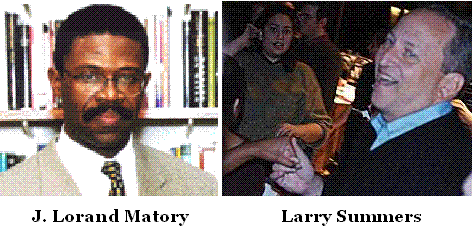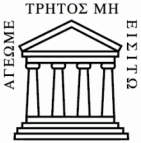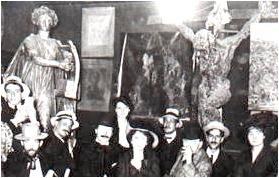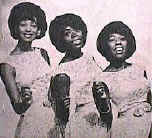See The Saints in this journal, as well as Claus and Fe.
Tuesday, November 27, 2018
Friday, March 4, 2011
Oh, When the Saints…
In memory of John Miner —
|
See also |
AMS logo—Note resemblance Click on pictures for details. |
This morning's LA Times —
Related remarks —
-
"I’ve heard of affairs that are strictly plutonic,
But diamonds are a girl’s best friend!" -
"In this talk, we will prove the diamond theorem and explore symmetries…."
– Log24 on the date of John Miner's death
Tuesday, December 15, 2020
Connection
Hurt’s dies natalis (date of death, in the saints’ sense) was,
it now seems, 25 January 2017, not 27.
A connection, for fantasy fans, between the Philosopher’s Stone
(represented by the eightfold cube) and the Deathly Hallows
(represented by the usual Fano-plane figure) —


Images from a Log24 search for “Holocron.”
Sunday, November 6, 2016
Major League Obit
Thursday, December 12, 2013
Communion of Saints
Saturday, April 21, 2012
But Seriously…
From Deadline Hollywood—
A film producer's death "between Friday night and early Saturday morning,"
April 13-14, 2012—
| R.I.P. Martin Poll
By THE DEADLINE TEAM | Sunday April 15, 2012 @ 7:36 pm PDT Veteran movie and TV producer Martin Poll died between Friday night and early Saturday morning of natural causes at a care facility on the Upper Westside in New York City. He was 89. |
See also the post linked to on the afternoon of Friday the 13th of April—
"All the saints have powers." — Cardinal Marchisano.
Happy birthday, James McAvoy (at left below in X-Men: First Class ).
Friday, April 13, 2012
Meditation for Friday the 13th
From Friday, May 13, 2005—
“All the saints have powers.”
See also Friday, April 13, 2007 and Friday, February 13, 2009.
Thursday, June 23, 2011
Script Magic…
In a Jewish Cathedral
From The New York Times Magazine of Sunday, April 6, 1986—
"David Rayfiel's Script Magic" by Alex Ward
WHEN THE CALL came last year to revise ''The Morning After,'' Rayfiel was working on a screenplay about the 1911 Triangle Shirtwaist Company fire for Barbra Streisand and Jane Fonda. He has now resumed work— as the principal writer, not the reviser— on that script. But chances are good that he will have further interruptions. Pollack will probably call and say, as he usually does, ''David, I need access to your brain.'' And Rayfiel will probably say, as he usually does, ''That's O.K., I'm not using it.'' He will revise another script, and be reluctant about taking credit for it.
''I guess it's like the medieval stonecutters who worked on the cathedrals,'' he says. ''There's all that elaborate work. The saints were carved by one guy, the cherubs by someone else. They didn't care about getting credit, they knew what they'd done. I'm like that. I'm the guy who does the cherubs.''
Related material:
Proginoskes in this journal and Abracadabra from the midnight of June 18-19.
See also Rayfiel's obituary in today"s Times .
For some quite different work, also from April 1986, see—
Thursday, February 3, 2011
Thursday, November 5, 2009
Universal Culture Machines
University of California anthropologist Alan Dundes:
"One could well argue that binary opposition is a universal. Presumably all human societies, past and present, made some kind of distinction between 'Male and Female,' 'Life and Death,' 'Day and Night' (or Light and Dark), etc." –"Binary Opposition in Myth: The Propp/Levi-Strauss Debate in Retrospect," Western Folklore, Winter 1997
To Levi-Strauss, I prefer Clifford Geertz —
"…what Levi-Strauss has made for himself is an infernal culture machine." –"The Cerebral Savage"
— and Heinrich Zimmer —
"…all opposition, as well as identity, stems from Maya. Great Maya is wisdom and increase, stability and readiness to assist, compassion and serenity. Queen of the World, she is alive in every nuance of feeling and perception; feelings and perceptions are her gestures. And her nature can be sensed only by one who has comprehended that she is the unity of opposites." —The King and the Corpse
And then there are more up-to-date culture machines.
Levi-Strauss, obtuse and boring, is an opposite, of sorts, to the smart and funny Dundes. The latter, in the binary opposition posed in yesterday's Log24 title "Sinner or Saint?," is definitely on the side of the saints. (See selected Log24 entries for the date of his death– Warren Beatty's birthday.)
Today's happy birthdays — Elke Sommer —
and Sesame Street —
Google logo today, Nov. 5, 2009
Click images for historical background.
Monday, March 13, 2006
Monday March 13, 2006
| Le Républicain Lorrain du 14 janvier 2001
Le Lapin Agile veille sur la Butte (par Michel Genson) 24 décembre 1900. Dans son atelier glacial du Bateau Lavoir, à flanc de la colline de Montmartre, Picasso se frotte les yeux. C’est bien Wasley, son ami Wasley, qu’il aperçoit traversant la place Ravignan, courbé sous le poids d’un grand Christ en croix. Le sculpteur titube et s’en va gravissant un à un les escaliers qui mènent au sommet de la Butte, direction la rue des Saules. Car l’œuvre est destinée aux murs du petit estaminet où la bande a trouvé asile, pour y échanger chaque soir des refrains, bocks et vaticinations les plus folles. La bande, c’est à dire Utrillo, Max Jacob, Modigliani et les autres… Un siècle et un souffle de légende plus tard, le même Christ blanc occupe toujours la même place, sous les lumières tamisées du Lapin Agile. À l’abri sous son aisselle droite, l’autoportrait de Picasso en Arlequin a été authentique en son temps. Jusqu’au jour où le grand Frédé, tenancier mythique du lieu, s’est gratté la barbe avant de le céder à un amateur suédois de passage. Depuis l’original a fait le voyage du MAM (Modern Art Museum) de New-York, et la Butte se contente d’une copie. Pour le reste, rien a changé ou presque pour le doyen des cabarets parisiens. Ni le décor, ni l’esprit. L’incroyable patine noire des murs, posée là par des lustres de tabagies rigolardes ou inspirées, rappelle au générique les voix des habituées de jadis, Apollinaire, Carco, Dullin, Couté, puis Pierre Brasseur, et plus proches de nous encore d’autres débutants, Caussimon, Brassens, François Billetdoux… La liste exhaustive serait impossible à dresser de tous ceux qui ont émargé au livre d’or du Lapin Agile. Malgré les tempêtes et les modes, le Lapin Agile dure et perdure donc. Et sa silhouette pour carte postale inspire toujours les peintres venus de partout. Comme si la halte faisait partie d’un parcours initiatique immuable. Deux pièces pour un minuscule rez-de-chaussée, dans la première, mi-loge, mi-vestiaire, une guitare attend son tour de projecteur. En l’occurrence un faisceau unique clouant le chanteur (l’humoriste ou le diseur) au rideau rouge de la seconde salle. Là où le spectacle se déroule depuis toujours, là où l’on s’accoude sans vergogne à la table d’Apollinaire, sous les lampes toujours drapées de rouge, pour écouter Ferré, Aragon, Mac Orlan ou les rengaines du Folklore populaire montmartrois. Yves Mathieu reste ferme, « ici, pas de sonorisation, pas de haut-parleur. Les gens découvrent la voix humaine. » Un refrain de Piaf glisse jusqu’au « laboratoire », le réduit où les autres artistes du programme dissertent sur l’état du monde. Les meubles de Bruant sont encore là, au hasard d’un coffre breton, un autre de marine, la façade d’un lit clos… « Des trucs d’origine » pour Yves Mathieu, qui malgré les vicissitudes du temps – il s’ingénie toute l’année durant à entretenir un établissement qui ne bénéficie d’aucun classement officiel, ni d’aucun subside – prêche haut et fort sa confiance, « parce qu’on aura plus que jamais besoin de racines, de repères, et qu’ici, c’est tout un pan de patrimoine qu’on défend à travers la chanson française, celle qu’on chante tous ensemble… » Le même secoue sa longue carcasse et se fend d’un sourire entendu : « Quand je descends à Paris, c’est pas pareil. Ici, le jour, c’est comme dans une église. Il y a le silence, et l’impression de ressentir les ondes laissées pare les cerveaux de ces types, là… » Aux murs, dessins ou tableaux laissés par Mac Orlan, Maclet ou Suzanne Valadon jouent avec l’ombre amicale. Le Lapin Agile, 22 rue des Saules, 75018 Paris. Tel : 01 46 06 85 87 |
Note the above description
of Christmas Eve 1900,
and the remark that
“Ici, le jour, c’est comme
dans une église.”
A search for more material on
the Wasley Christ leads to
Princeton’s Nassau Church:
|
The fullness of time. I don’t have to call on the physicists among us to conclude that this fullness was not meant to be the end of the time line. That Paul must not have been talking about time in a linear way. Fullness. Complete. Almost perfect. Overflowing with grace. Just right. Fullness. As in “the earth is the Lord’s and the fullness thereof.” Fullness. As in “I pray that you may have the power to comprehend with all of the saints, what is the breadth, and length, and height and depth, and to know the love of Christ that surpasses all knowledge, so that you may be filled with all the fullness of God.” Fullness. As in “For in Christ, all the fullness of God was pleased to dwell.” “When the fullness of time had come, God sent his Son, born of a woman.” I can remember Christmas Eve as a child….
— Christmas Eve, 2004, |
Religious Symbolism at Princeton,
on the Nassau Church,
Counting Crows on
the Feast of St. Luke
(“Fullness… Multitude”),
The Quality of Diamond,
in memory of
Saint Hans-Georg Gadamer,
who died at 102
four years ago on this date,
and
Thursday, February 2, 2006
Thursday February 2, 2006
continued

The Gospel According to
Father Hardon:
TELEPATHY. The direct communication of ideas from one mind to another without words, signs, gestures, or any other ordinary means of communicating thought. Extensive data and years of psychical research indicate that such manner of communicating knowledge does occur in exceptional cases or with exceptional people. When verified, the phenomenon is purely natural and the use of telepathic powers by one who possesses them cannot be called divination, nor does their use pose any special moral problems. It should be judged by the general principles applicable to any other human being’s behavior.
It is altogether another question whether in a given case of reputed telepathy any preternatural agency has been active. Instances of supposed communication of thought without verbal or other sensory means are reported in the lives of the saints. But the Church does not hold that such phenomena are positive signs of a person’s sanctity. (Etym. Greek tēle, at a distance + pathein, to experience.)
Related material:
 |
 |
Saturday, September 10, 2005
Saturday September 10, 2005
“When asked which words in the English language are the most difficult to define precisely, a lexicographer would surely mention funky.”
“Founded by Isaac Kaufmann Funk, a Lutheran minister who in 1876 began editing and publishing two magazines, The Homiletic Review and The Voice, the latter for the Prohibition Party. Unfortunately, neither magazine paid its way. The following year he teamed with [one of his classmates at Wittenberg College] A.W. Wagnalls, a lawyer and accountant, who got Funk on sounder financial footing. They began by publishing pamphlets and booklets for the clergy, mostly commentaries on the Bible.”
— Major American Publishers and Wikipedia
* Company: “The Grateful Dead”– “a name chosen at random from a dictionary– some claim it was a Funk & Wagnalls, others an Oxford Dictionary– by Jerry Garcia“
Saturday September 10, 2005
(Background: the two previous entries.)

Alicia Keys and Paul Simon
on last night’s Katrina telethon
Readings for St. Patrick’s Day,
Log24.net, March 17, 2005,
featuring
Conrad’s Under Western Eyes.
Reading for the Saints of 9/11,
New York Times of Sunday, 9/11, 2005:
“The True Classic of Terrorism,”
Conrad’s Under Western Eyes.
And for some comic relief,
Harvard’s President on St. Patrick’s Day:
Professor Matory is “a renowned expert on Brazil and on the Yoruba civilization of West Africa, which is world famous for its religious complexity and artistic creativity. He is equally noted for his study of such Latin American religions as Haitian ‘Vodu,’ Brazilian Candomblé, and Cuban Santería….”

Play that funky music, white boy.
Sunday, September 4, 2005
Sunday September 4, 2005
“A family of musicians took shelter for the night
In the little harbor church of St. Cecilia”
— Paul Simon, Rhythm of the Saints
“The canonized go on.”
— Philip Roth in
today’s New York Times,
“Why Is This Man Smiling?“
“Have the ensemble clap the rhythm of the first four treble clef bars of Bach’s Minuet in G, and then play it with correct pitches or in a unison single pitch. Next, have them clap the bass clef rhythm and play it either in unison or with correct pitches. Finally, have one group play the treble part while the other group claps the bass part, and then reverse roles as above.”
Friday, May 13, 2005
Friday May 13, 2005
Powers
From today’s New York Times —
Francesco Marchisano, made a cardinal
on October 21, 2003:
“All the saints have powers.”
Tonight at 8 PM ET on Fox: X-Men.
Tuesday, May 13, 2003
Tuesday May 13, 2003
Operation Playmate:
On this date in 1938, Louis Armstrong and his orchestra recorded “When the Saints Go Marching In.”
On this date in 1961, Saint Gary Cooper died.
From my Jan. 2, 2003, entry:
Faces of the Twentieth Century:
The Harvest Continues
“I walk, I lift up, I lift up heart, eyes,
Down all that glory in the heavens
to glean our Saviour;
And, éyes, héart, what looks, what lips
yet gave you a
Rapturous love’s greeting of realer,
of rounder replies?”
— Gerard Manley Hopkins,
“Hurrahing in Harvest”
|
|
|
“Cowboy, take me away.
Fly this girl as high as you can
into the wild blue.”
From my March 31, 2003, entry:
“During the Gulf War, Playboy magazine’s celebrated Centerfolds reached out to U.S. military men and women… with their ‘Operation Playmate’ project….
Now, in light of the war in Iraq, ‘Operation Playmate’ has returned.”
Entertainment Weekly, May 2, 2003:

Perhaps, in heaven, Dixie Chick Natalie “Mattress Dancing” Maines will provide terpsichorean instruction.
Etymology: Latin Terpsichor
,
from Greek Terpsikhor,
from feminine of terpsikhoros,
dance-loving : terpein, to delight
+ khoros, dance.
See, too, my entry for Beltane (May 1), the day that death claimed the 13th Episcopal bishop of New York City.
All of these events are not without interest, but it is not easy to fit them into one coherent story, as Robert Penn Warren once requested:
“The name of the story will be Time,
But you must not pronounce its name.
Tell me a story of deep delight.”
It is perhaps relevant that, as T. S. Eliot well knew, there can be no dance except in time, and that the time of my May 1 entry is 5:13, today’s date in another guise. To paraphrase an Eliot line,
“Hurry up please, it’s 5/13.”
Sunday, March 2, 2003
Sunday March 2, 2003
7:20 PM CALI Time
The Bus and the Bead Game:
The Communion of Saints as
the Association of Ideas
On this date in 1955, “Bus Stop,” a play by William Inge, opened at the Music Box Theatre in New York City.
“I seemed to be standing in a bus queue by the side of a long, mean street.”
— C. S. Lewis, The Great Divorce, opening sentence
Today’s birthdays:
Sam Houston
Dr. Seuss
Kurt Weill
Mikhail Gorbachev
Tom Wolfe
Desi Arnaz
Jennifer Jones
Karen Carpenter
and many others.
Today is the feast day of
St. Randolph Scott,
St. Sandy Dennis,
St. D. H. Lawrence, and
St. Charlie Christian.
“Your guitar, it sounds so sweet and clear…”
— Karen Carpenter singing “Superstar“
“And if I find me a good man,
I won’t be back at all.”
See (and hear) also “Seven Come Eleven,” played by St. Charlie Christian.
One might (disregarding separation in time and space — never major hindrances to the saints) imagine C. S. Lewis in Heaven listening to a conversation among the four saints listed above. For more on the communion of saints, see my entry “State of the Communion” of Tuesday, Jan. 28, 2003. This entry, quoting an old spiritual, concluded with “Now hear the word of the Lord” — followed by this notation:
7:11 PM.
See also the N.Y. Times obituary of John P. Thompson of Dallas, former 7-Eleven chairman, who died, as it happened, on that very day (Jan. 28). See also Karen Carpenter’s “first take luck.”
The sort of association of ideas described in the “Communion” entry is not unrelated to the Glasperlenspiel, or Glass Bead Game, of Hermann Hesse. For a somewhat different approach to the Game, see
by John S. Wilson, group theorist and head of the Pure Mathematics Group at the University of Birmingham in England. Wilson is “not convinced that Hesse’s… game is only a metaphor.” Neither am I.
For the association-of-ideas approach, see the page cited in my “Communion” entry,
“A Game Designer’s Holy Grail,”
and (if you can find a copy) one of the greatest forgotten books of the twentieth century,
The Third Word War,
by Ian Lee (A&W Publishers, Inc., New York, 1978). As Lee remarks concerning the communion of saints and the association of ideas,
“The association is the idea.”
Tuesday, January 28, 2003
Tuesday January 28, 2003
State of the Communion
Relevant readings:
- Definition of the communion of saints in the Catholic Encylopedia —
“In that communion there is no loss of individuality, yet such an interdependence that the saints are ‘members one of another’ (Rom., xii, 5)….”
- Ephesians 4:16 —
- A Game Designer’s Holy Grail —
“Herman Melville described the exact process beautifully in his novel, Mardi:
‘In me, many worthies recline, and converse. I list to St. Paul who argues the doubts of Montaigne…'”
- Invitation to the HipBone Games —
“…man is seen as he is sub specie aeternitatis, an ‘immortal diamond.'”
- Your Hip Bone Connected —
“Now hear the word of the Lord”
“…the whole body fitly joined together and compacted by that which every joint supplieth….”

















